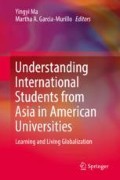Abstract
This introductory chapter presents key rationales, the main argument, and the organization of the book. It argues that there is a power asymmetry between Asian students and American universities, and this power asymmetry provides one of the fundamental social contexts in which Asian international students at American universities are situated. This power asymmetry also sets up the academic discourse for studying these international students with a traditional deficit framework that emphasizes their adjustment and adaptation. It argues for the urgency to shift from the deficit framework to the one calling for proactive institutional efforts engaging both international students and American university to bring about successful experiences of international students.
Access this chapter
Tax calculation will be finalised at checkout
Purchases are for personal use only
References
Al-Sharideh, K. A., & Goe, W. R. (1998). Ethnic communities within the university: An examination of factors influencing the personal adjustment of international students. Research in Higher Education, 39(6), 699–725.
Barnett, G. A., & Salisbury, J. G. T. (1996). Communication and globalization: A longitudinal analysis of the international telecommunication network. Journal of World System Research, 2(16), 1–17.
Bevis, T. B., & Lucas, C. J. (2007). International students in American colleges and universities: A history. Palgrave Macmillan.
Caruana, V., & Hanstock, J. (2008). Internationalising the curriculum at the University of Salford: From rhetoric to reality. The global university: The role of senior managers (pp. 31–35).
Caruana, V. (2010). Global citizenship for all: Putting the ‘higher ‘back into UK higher education? In Globalization and internationalization in higher education: Theoretical, strategic and management perspectives (pp. 51–64).
Dolby, N., & Rahman, A. (2008). Research in international education. Review of Educational Research, 78(3), 676–726.
Fong, V. (2011). Paradise redefined: Transnational Chinese students and the quest for flexible citizenship in the developed world. Stanford: Stanford University Press.
Gareis, E. (2012). Intercultural friendship: Effects of home and host region. Journal of International and Intercultural Communication, 5(4), 309–328.
Giddens, A. (1990). The consequences of modernity. Stanford: Stanford University Press.
Hanassab, S. (2006). Diversity, international students, and perceived discrimination: Implications for educators and counselors. Journal of Studies in International Education, 10(2), 157–172.
Hechanova-Alampay, R., Beehr, T. A., Christiansen, N. D., & Van Horn, R. K. (2003). Adjustment and strain among domestic and international student sojourners a longitudinal study. School Psychology International, 23(4, 2002), 458–474.
Henry, F., & Tator, C. (2007). Through a looking glass: Enduring racism on the university campus. Academic Matters, 24–25.
Hills, S., & Thom, V. (2005). Crossing a multicultural divide: Teaching business strategy to students from culturally mixed backgrounds. Journal of Studies in International Education, 9(4), 316–336.
International Institute of Education Open Doors Data. (2014). Retrieved from http://www.iie.org/Research-and-Publications/Open-Doors/Data/US-Study-Abroad/All-Destinations/2012-14
International Institute of Education Open Doors Data. (2016). Accessed 30th June 2016 via http://www.iie.org/Research-and-Publications/Open-Doors/Data/International-Students/By-Academic-Level-and-Place-of-Origin/2014-15
Jones, E. (2010). Internationalisation and the student voice: Higher education perspectives. New York: Routledge.
Leask, B. (2001). Bridging the gap: Internationalizing university curricula. Journal of Studies in International Education, 5(2), 100–115.
Leask, B. (2010). Chapter 1: Beside me is an empty chair – The student experience of internationalisation. In Jones E. (Ed.), Internationalisation and the student voice: Higher education perspectives (pp. 3–17). New York: Routledge.
Leask, B. (2013). Internationalizing the curriculum in the disciplines – Imagining new possibilities. Journal of Studies in International Education, 17(2), 103–118.
Lee, J. J. (2010). International students’ experiences and attitudes at a US host institution: Self-reports and future recommendations. Journal of Research in International Education, 9(1), 66–84.
Lee, J. J., & Rice, C. (2007). Welcome to America? Perceptions of neo-racism and discrimination among international students. Higher Education, 53, 381–409.
Pritchard, R. M. O., & Skinner, B. (2002). Cross-cultural partnerships between home and international students. Journal of Studies in International Education, 6(4), 323–353.
Trice, A. G. (2007). Faculty perspectives regarding graduate international students’ isolation from host national students. International Education Journal, 8(1), 108–117.
Wallerstein, I. (1979). The capitalist world-economy: Essays. Cambridge: Cambridge University Press.
Whitsed, C. & Green, W. 2015. Internationalisation of the curriculum and the ‘new normal’: An Australian perspective. International Higher Education: 5th Issue.
Zakaria, F. 2008. The post-American world. New York, p. 4.
Zhao, Chun-Mei, Kuh, G. D., & Carini, R. M. 2005. A comparison of international student and American student engagement in effective educational practices. Journal of Higher Education, 76, 209–231.
Author information
Authors and Affiliations
Corresponding author
Editor information
Editors and Affiliations
Rights and permissions
Copyright information
© 2018 Springer International Publishing AG
About this chapter
Cite this chapter
Ma, Y. (2018). Paradigm Shift: Learning Is a Two-Way Street Between American Universities and Asian International Students. In: Ma, Y., Garcia-Murillo, M. (eds) Understanding International Students from Asia in American Universities. Springer, Cham. https://doi.org/10.1007/978-3-319-60394-0_1
Download citation
DOI: https://doi.org/10.1007/978-3-319-60394-0_1
Published:
Publisher Name: Springer, Cham
Print ISBN: 978-3-319-60392-6
Online ISBN: 978-3-319-60394-0
eBook Packages: EducationEducation (R0)

